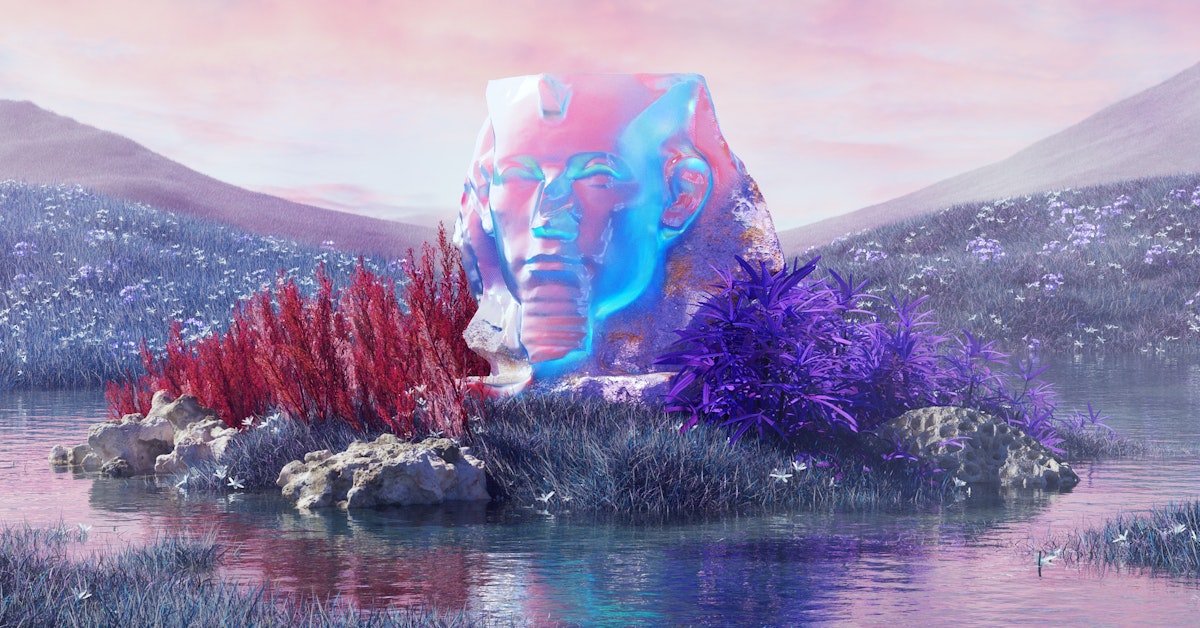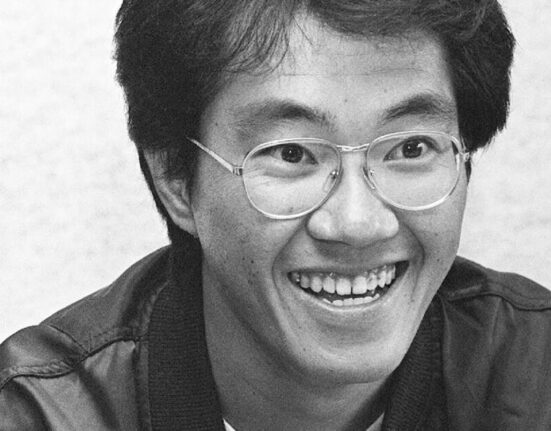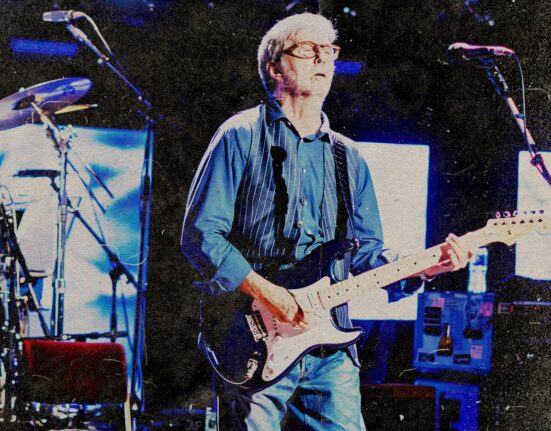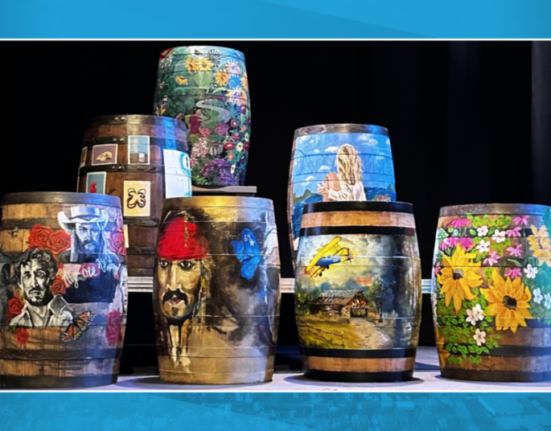Credits
Alizeh Kohari is a Pakistani journalist.
Chidi Nwaubani grew up in London with the vestiges of colonial plunder all around him. It’s all stolen — these people are thieves, his mother would say of the jewels in the Queen’s crown or other ill-gotten artifacts now “unwillingly held” outside Africa and elsewhere. On the other hand, he told me, during visits to museums in Nigeria, where his family originated, what struck him most was a glaring absence: As much as 95% of all artwork from sub-Saharan Africa, he would later learn, is outside the continent.
In late 2021, Nwaubani, a product designer for corporate brands, was dabbling in cryptocurrency and non-fungible tokens (NFTs). He was struck by the potential of NFTs to create artwork with irrefutable, technologically determined ownership, a way to at least partly right the seemingly unending failures of former colonial powers to return what they stole. NFTs, he hoped, might also mitigate some of the historical baggage that accompanied those returns. “Imagine: You’re taken from your parents when you’re a child and returned when you’re 80 years old,” he explained. “Yes, it’s the right thing to do and obviously, we’re happy to see you back — but we’re also sad because you’ve come back different and the place you’ve returned to has changed.”
So he came up with a plan.
“We’re going to go to the British Museum,” he told me last fall, recounting the scheme. “We’re going to wear balaclavas, dress in all black, wear masks.” The target: hundreds of objects from the historic Kingdom of Benin, in what is now southern Nigeria, including some of the Benin Bronzes, a collection of plaques and sculptures looted by the British in 1897.
Nwaubani and others had formed an art collective they called Looty, and at the museum they planned to capture the bronzes on display — digitally, using a LiDAR app on mobile devices. Then they would “reclaim” the artifacts by turning those 3D renderings into NFTs.
He grinned. “This is how we restart the story.”
“We’re going to go to the British Museum. We’re going to wear balaclavas, dress in all black, wear masks.”
—Chidi Nwaubani
Looty, named after a Pekingese dog captured during the Second Opium War and presented to Queen Victoria as a pet, later described the “heist” as “the world’s first digital repatriation of stolen art to the metaverse.” Heist may be a slight oversell — since the British Museum allows visitors to create 3D scans for “private and noncommercial purposes,” no one broke any rules by scanning the bronzes. But the underlying concept of returning cultural heritage in a digital format to the people and places from which it originated is an important strand of the effort to right the wrongs of the colonial era.
Countries and communities have long been demanding colonial loot be returned; written records show such negotiations taking place since at least the 1800s. In recent years, the push for the repatriation of African art in particular has accelerated, but overall, according to the research collective Open Restitution Africa, of the more than 1 million known artifacts removed from the continent, fewer than 1,000 have been returned.
Digital repatriation first gained momentum among anthropologists in the early 2000s. Western museums were teeming with artifacts, many of them plundered or seized during colonial rule, others collected by explorers or academics without clear consent. For a new crop of researchers, new technologies presented an opportunity to recirculate what had been snatched from communities — a forgotten song, a lost manuscript, a scared object, each item a repository of generations of knowledge.
Meanwhile, enthralled by advancements in 3D imaging, museums were zealously digitizing their collections, hoping to spur engagement beyond the confines of the white cube. Online collection management systems were trumpeted as a way to connect museums and, consequently, the shards of history strewn across the world. Moreover, as 3D printing became more widespread — in 2011, The Economist, a 3D-printed Stradivarius violin on its cover, compared the technology to the advent of the factory and mass production during the Industrial Revolution — some museums also began toying with the idea of “virtual returns.” This provoked swift skepticism and suspicion. “If the digital is so good,” the Zuni tribal leader Jim Enote asked a gathering at the Smithsonian the following year, “why don’t you keep it?”
Only gradually did it dawn upon researchers and curators that in their effort to digitize stolen art and history — thereby making it accessible not just to their rightful heirs, but to everyone, anywhere — they had inadvertently created a new layer of ownership and control. As it turns out, in the digital realm, just as in the physical one, nothing is freely available to all forever.
“In the digital realm, just as in the physical one, nothing is freely available to all forever.”
Six years before Looty’s digital heist, two artists used a modified Xbox Kinect hidden under a blue scarf to scan one of the most recognizable sculptures in the world: the 19-inch-tall, 3,400-year-old bust of Queen Nefertiti. Held in Berlin’s Neues Museum, Egypt claims that the bust, thought to have been sculpted by the great Egyptian artist Thutmose, was smuggled to Germany in 1913. It draws around a million visitors to Berlin each year.
The Neues Museum does not permit photography of some items in its collections, which the artists, Nora Al-Badri and Jan Nikolai Nelles, knew. That was partly the point: to highlight the gatekeeping of artifacts and their data by Western museums. Later, the artists say, they handed over the sensor data to an anonymous group of hackers who returned a high-quality .stl file, the format typically used for 3D imaging and computer-aided design. Then they released it online as a torrent file under a Creative Commons license, allowing anyone with a 3D printer to recreate the iconic sculpture.
Soon, however, their intervention became embroiled in a different debate over the technicalities of copyright law. The quality of the artists’ scan, some imaging experts pointed out, was too good to have been produced using a Kinect; the more likely explanation, they suggested, was that the artists had acquired the museum’s own scan of the bust — created for archiving, preservation and limited-edition gift shop replicas — either by hacking or from someone with inside access. Likely for legal reasons, the artists remained vague, offering little by way of clarification. But the conversation had shifted from the colonial theft of the bust itself to the originality of the digital scan.
Nearly a decade later, speaking from Berlin, Al-Badri reflected on the sluggish pace of heritage restitution since. “Many museums guard the digital datasets of their collections as much as the physical collections,” she said. She added that in some cases, institutions seem to think making collections public in digital form may lessen calls to restitute the physical works.
In other instances, physical repatriation is being made contingent on Western museums retaining digital copies. A 2018 French government review of African artwork in publicly owned French collections, the Sarr-Savoy report, recommended systematically digitizing and making available online all heritage designated for repatriation. More than 100 international art researchers and curators expressed reservations, noting that this risked “placing the French government in a position of returning Africa’s material cultural heritage while retaining control over the generation, presentation and stewardship of Africa’s digital cultural heritage for decades to come.”
Al-Badri, who is German with Iraqi roots, grappled with this too. “It would have been fair for Egyptians to question why we, as artists, decided to put Nefertiti on the public domain and give it to the whole world,” she said. “But actually, no Egyptian ever asked me that.” Asked to gift the now infamous 3D-printed bust they had made to the Egyptian government in an official ceremony, however, the artists demurred, opting to bury it somewhere in the Sahara for someone to potentially unearth in the future. “I’m not so much for nation-states, either,” she shrugged.
“Just because something is digitized doesn’t mean it will exist forever.”
The borders between nations today, both former colonizers and former colonies, can complicate the process of repatriating artifacts, which were often plundered prior to the existence of those states. Digital repatriation sometimes seems to Western museum leaders as a way to circumvent the tangle of claimants and jurisdictions.
A few years ago, Nicole Crawford, the chief curator at the University of Wyoming Art Museum, became intrigued by the idea of digital restitution of almost 200 objects in the museum’s permanent collection that originated in Rapa Nui, known in colonial times as Easter Island. Carved from volcanic rock, stone and wood, the small sculptures were created — mostly in the 20th century — to honor ancestors and ward off evil and misfortune.
Crawford and her colleagues tried to digitally “return” the sculptures to the Father Sebastian Englert Anthropological Museum in Rapa Nui. The legal process of physical repatriation “was not straightforward,” she told me, in part because the island, annexed by Chile in 1888, remains a “special territory” of the country — effectively a colony. “Do we send it back to Chile?” Crawford recalled wondering. “Do we send it to the Rapa Nui people? Who is legally in charge?”
In a similar way, cleavages left by former empires have complicated the physical restitution of the Benin Bronzes, a process ostensibly delayed by a long-running dispute over who, today, should be considered their rightful owner: Nigeria’s government or the oba, the ceremonial king of Benin, to whose ancestors the bronzes originally belonged? Further complicating matters, in 2022, a New York-based African-American reparations group tried to claim the bronzes, arguing that descendants of slaves ought to have co-ownership over the ones in Western museums since they are partly made from manillas, brass and copper rings introduced as currency in western Africa by European slave traders.
In Wyoming, Crawford’s digital repatriation project, which was put on hold in 2020 due to Covid, would have involved an exhibition of 3D-printed replicas on Rapa Nui and in the U.S. “We would 3D print their pieces and they would 3D print ours,” she said. “But we would do it so it would be noticeable what’s missing and bring attention to the idea of collections being spread across the globe.” Now, however, reflecting on the project, Crawford wonders if the objects should’ve been digitized at all. “We didn’t ask for permission [from the source communities],” she said. “We didn’t think about these things. And I feel that was our downfall.”
She now finds herself in a rather curious fix: The digital files of the scanned Rapa Nui objects don’t belong to the museum but to the University of Wyoming. “If I wanted to send all the files back to Rapa Nui, which we should do, I can’t because I don’t have the permission to do so within my own institution,” she said. “Maybe digital repatriation shouldn’t even be a first step,” she added. “If it needs to be physically returned, we return it.”
Just because something is digitized doesn’t mean it will exist forever, either. Digital platforms and data disappear all the time. Steve Nash, who until 2023 was the director of anthropology at the Denver Museum of Nature and Science, pointed out that there are practical hurdles like capacity and budget if Western museums insist on holding onto digitized surrogates. “That promise of a unified museum database was always a pipe dream, especially since it costs museums more to curate the digital asset than the physical,” he said. “The digital world is determined, for lack of a better term, by for-profit companies that have to make money for their stakeholders. So planned obsolescence is part of what they do, and then there’s changes in computing power. Given my experience, those digital scans will be gone in five years, probably.”
On a former Unilever plantation at the confluence of the Kwenge and Kwilu rivers in the Democratic Republic of Congo, a group of artists known as Cercle d’Art des Travailleurs de Plantation Congolaise, or Congolese Plantation Workers Art League, have been trying for years to retrieve an important piece of their history: a 2-foot-tall sculpture of Maximilien Balot, a colonial administrator in the Belgian Congo colony. By all accounts, Balot was a brutal overlord. He was killed in 1931 during the last great armed uprising against the colonial state before Congo became independent. By the time the rebellion was suppressed, as many as a thousand Pende people had been murdered.
The artists had learned that the uprising was fought in part against the recruitment of forced labor on a plantation in their hometown of Lusanga. The Balot sculpture, carved there soon after the rebellion in an effort to contain and redirect the malevolent spirit of a hated overseer, is now housed in the Virginia Museum of Fine Arts.
In 2020, Ced’art Tamasala and Mathieu Kilapi Kasiama, two of the founding members of the CATPC, made the long journey from Lusanga to the United States to see the statue in person. It happened to be on loan to a Swiss museum for an exhibition that aimed to “critically assess the repercussions” of colonialism when they arrived. “While we are happy that the sculpture can travel and be seen by the public in Zurich,” said Tamasala, “we also need it to travel home, so that our public in Lusanga can also see it.”
Since 2014, members of CATPC — facilitated by Dutch artist Renzo Martens, whose interventions have long befuddled, offended and intrigued the art world — have been crafting sculptures from riverine clay and then digitally scanning them. They send the files to Amsterdam, where they are cast in chocolate and sold in mostly European art galleries. In 2017, using some of the proceeds from these sales, the collective founded an art gallery in Lusanga. “We even put air conditioning in it,” the artists said, a wink at the types of rationale brought forth by some institutions resisting the return of artifacts because of conditions in the countries of origin.
But the collective’s requests for a loan of the Balot sculpture were repeatedly rebuffed. So, in early 2022, the artists downloaded a photo of the sculpture from the museum’s website and turned it into an NFT, layering over it a drawing of the “global value chains of capital, commodities and art.”
The artists, many of them former agricultural workers, were mostly interested in the material possibilities of NFTs. “It was a way to use the force of the sculpture to resist, to bypass institutions and to free ourselves,” Tamasala told me over a WhatsApp video call last fall. “And for us, the first freedom is to be on our own land.” Sixty-five copies of the NFT have sold so far, with the collective using the proceeds to purchase at least 50 hectares of their ancestral land from the companies that had replaced Unilever (and that continue to produce palm oil for Unilever products).
The NFT market is far more subdued today than when the Balot NFT went on sale; by the end of 2022, trading volumes had plummeted 97% from a peak at the beginning of the year. Around the same time as the Balot NFT release, Looty put out an initial set of five NFTs based on the Benin Bronzes, setting up a fund to support young African artists with 20% of all proceeds. None have sold.
Meanwhile, in an echo of the controversy over the digital Nefertiti bust, the Virginia Museum of Fine Arts initially protested that the source image for the Balot NFT had been lifted directly without permission, a violation of their open-access policy. But the museum did ultimately reconsider its stance on loaning the physical sculpture. Last fall, when I talked to Tamasala, he said “maybe next year, it will be here!” He jabbed the air with his cigarette. “Thanks to the NFT. Inshallah. Inshallah.” This month, temporarily, the Balot sculpture finally returned to Lusanga.
“For us, the first freedom is to be on our own land.”
—Ced’art Tamasala
Last summer, Nwaubani and his Looty co-founder Ahmed Abokor once again infiltrated the British Museum. This time, they set their LiDAR scanners on a different target: the ancient slab of granodiorite that helped scholars crack Egyptian hieroglyphic scripts. Shipped from the Egyptian port city of Rashid to England in 1802, Hajar Rashid — the Rosetta Stone — has been on display at the British Museum ever since. Like the bust of Nefertiti, Egyptians have long demanded its return; the museum has repeatedly refused, citing an 1801 treaty.
Looty’s objective for this intervention was to return a digital version of the artifact rather than actually claim digital ownership of it. “We don’t really know who owns the Rosetta Stone, given that it’s in several different languages,” Nwaubani explained. “Its former location, though, we definitely know.”
After obtaining the scan, he flew from London to Egypt, drove to Rashid and, through location-based augmented reality technology similar to Pokémon Go, he “returned” the stele to the site of its discovery by the Nile Delta. Visitors to the Citadel of Qaitbay can scan a QR code on display and view the stele on their smartphones in augmented reality.
Later, Looty also attempted to “return” the Benin Bronzes — to their original context. In an installation for the Venice Biennale last year, Looty used 3D replicas, holograms, sound and augmented reality to show the thousands of artifacts as they existed inside the Edo royal palace in Benin City before it was pillaged. “It’s meant to be something that can be accessed anywhere, as long as you have a device that can enable Snapchat,” he said. “We can have this on the side of the road, in Accra, in Lagos, in the middle of New York City.”
Digitally restituted objects, said Chao Tayiana, a co-founder of Open Restitution Africa, can allow audiences to engage “not just with the object, but also its loss and the emotional facets of why it isn’t there in the first place.” Interventions like Looty’s, she added, are “extremely important in pushing boundaries and buttons” because they exist outside institutional frameworks that dictate how cultural knowledge should be circulated. “What they do is create room for people to imagine and to create. And I think that’s incredibly important in any society.”
“Contrary to the idea of open access as an unmitigated good, in this worldview, knowledge is relational: Who transmits it and when and how are just as important as what is transmitted.”
In 2017, a researcher named Maria Luísa Lucas embarked on a journey up the Igara Paraná, a river in the Amazon basin in Colombia. With her she carried dozens of microSD cards and flash drives and a small portable speaker.
Lucas was fulfilling a promise she had made to the Indigenous Bora people, with whom she had been working for several years: to return a series of audio files of ritual songs, some long forgotten, that had been recorded by a Franco-Swiss anthropologist half a century earlier. With the consent of Bora elders and chiefs, Lucas had digitized the recordings, which were stored on magnetic tapes in a university archive in Paris, and was now bringing them back. Where the community lives is so remote, she told me, it can take 25 days to reach by boat; there is no telecom network, so I was unable to speak with anyone there.
Lucas’ initial objective in returning the recordings was to gather more information: to learn the songs associated with different Bora rituals and to identify singers, speakers and musical instruments. Through conversations with community elders, she realized that she could also help revitalize pieces of their culture that had been lost to them. As she traveled across the territory, distributing copies of the recordings to families whose relatives were on them, she listened to them expound on the connections between chants, rituals and myths, watched them perform the dance steps associated with particular songs or somberly recall their ancestors. This is my mother, one person said. It seems that he is alive, here by my side, said another.
Lucas, now an assistant professor at the University of São Paulo, had assumed that the Bora community would want the French university where the original recordings are stored to either return them or revert control of them to the Bora. (They already cannot be accessed online.)
But the Bora community wasn’t concerned with outsiders listening to recordings, Lucas told me — not even the shamanic chants whose dissemination is typically tightly regulated. The recordings themselves hold no power for the uninitiated, one of her interlocuters told her. What’s critical is not the content of the songs but how they are transmitted. If they aren’t passed down from elders to youths within the community, they are “just poetry.”
Lucas, surprised, learned that Bora elders were often more worried that some within their own community may utilize the recordings in non-traditional ways, like young men moving to cities and brandishing their Indigenous identities to pander to foreigners and tourists. “If you have all the knowledge recorded in digital files … and if everything is accessible to young people, then old people won’t be necessary anymore,” Lucas said.
Contrary to the idea of open access as an unmitigated good, in this worldview, knowledge is relational: Who transmits it and when and how are just as important as what is transmitted. “If knowledge doesn’t involve this kind of relation, it will not work,” Lucas said. “It won’t be real knowledge.” In other words, knowledge is a gift to be passed down from generation to generation; lacking that context, it’s just a commodity.







